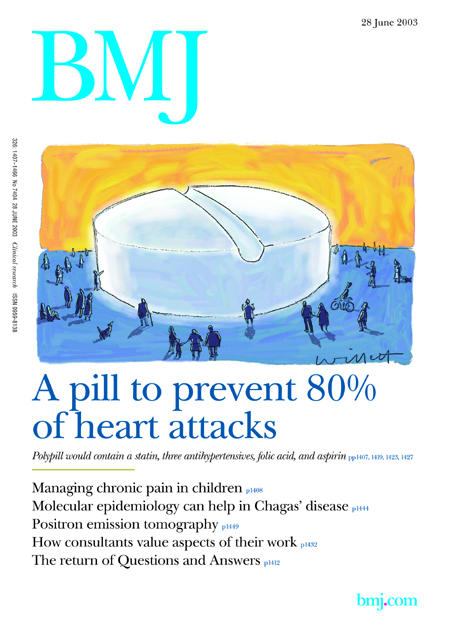Editor—Wald and Law's provocative paper and the accompanying editorial on the “Polypill” was disappointing in focusing only on the advantage to the population and ignoring the individual's views of the benefit he or she would wish to see from taking preventive drugs.1,2
The median threshold of absolute risk reduction below which patients would not wish to take a preventive drug may be as high as 30% over five years. This is far higher than the benefit of the Polypill, which offers a meagre 7% reduction over 10 years if started at age 55.3 We and others found this benefit would be acceptable to only one in 10 healthy people.3 If only one in 10 take the Polypill the effect on the population will be negligible.
It all comes down to accurate numerical presentation and framing of the benefits of drugs to patients. As the patient's treatment broker, doctors are duty bound to inform their healthy 55 year old patient that if he or she takes the Polypill for the next 10 years the chance of benefit will be less than 1% per year and that of side effects 6% overall, some of which (such as aspirin related gastro-intestinal haemorrhage) may be life threating1
Furthermore, if the polypill is successful their patient's chance of dying from cancer, trauma, and degenerative brain disease will increase with the effectiveness of the Polypill, as even with Polypill treatment, mortality will remain stubbornly 100%.
Figure 1.

Some patients will do anything to prevent a heart attack or stroke. Some will take any treatment if their doctor recommends it. In the modern health service, whose focus is increasingly on health promotion rather than treating disease, doctors need to be numerically well informed and to be able to present data on drug effectiveness which are relevant to their patient as a person.
Journal editors have a tremendous responsibility to support doctors in this task by insisting that authors emphasise figures denoting the reduction in absolute risk. Given these figures for the Polypill, most doctors and patients will be considerably less enthusiastic than the authors of this paper and editorial.
Competing interests: None declared.
References
- 1.Wald NJ, Law MR. A strategy to reduce cardiovascular disease by more than 80%. BMJ 2003;326: 1419-24. (28 June.) [DOI] [PMC free article] [PubMed] [Google Scholar]
- 2.Rodgers A. A cure for cardiovascular disease. BMJ 2003;326: 1407-8. (28 June.) [DOI] [PMC free article] [PubMed] [Google Scholar]
- 3.Trewby PN, Reddy AV, Trewby CS, Ashton VJ, Brennan G, Inglis J. Are preventive drugs preventive enough? A study of patients' expectation of benefit from preventive drugs. Clin Med 2002;2: 527-33. [DOI] [PMC free article] [PubMed] [Google Scholar]


